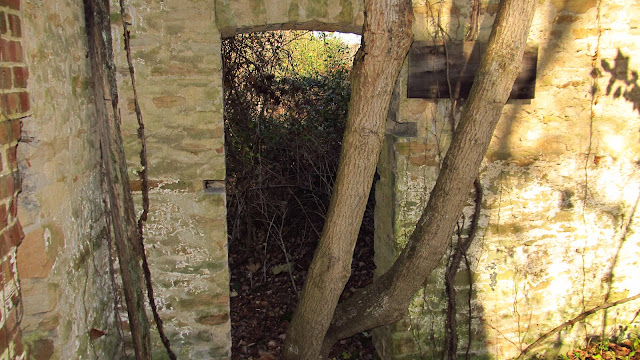The Orient Mine and Coke Works was a pretty big operation in its day. The coke plant consisted of 480 ovens and I could find only traces. The ovens have been reclaimed. Supposedly there is still a handful left but I couldn't even find one. Believe me when I say I scoured the area pretty good. What does remain are a couple very impressive buildings from the mine. Still extant are a huge coal bin and everything but the roof and equipment of the power house.
The Orient Coke Company began operating the mine in May 1904, but development was not well underway until October of that year. By the end of 1907 nearly 400 acres had been developed with over 90 acres of coal mined. The 480 ovens were running at full capacity and established a record in the region for 1907. Charles Oppermann was the superintendent for the works. The company owned 215 acres of surface land which consisted of the mine buildings, coke works, company houses, stone quarry and a farm. The general manager was O.W. Kennedy.
This is a photo of the surface mine works in 1907:
 |
A closeup of the map showing the bin and shaft. |

An older map detailing the buildings. The shaft and bin are circled in red. Foundations for most of these buildings also exist.

An older map detailing the buildings. The shaft and bin are circled in red. Foundations for most of these buildings also exist.
Anyway, that's what was there. Here's what's here today:
 |
Approaching the power house. |
 |
Bricked up window. |
 |
Huge stone archway. |
 |
Another bricked up window. |
 |
Another archway facing the coal bin. |
 |
Interior of the power house. |
 |
Old wiring knobs. |
 |
Evidence of fire. |
 |
More interior shots. |
 |
Brick interior doorway. |
 |
A tree growing in from the outside. |
 |
Exterior wall. |
 |
Old hardware toward the top of the building. |
 |
More evidence of fire. |
 |
Heading over to the coal bin. |
 |
This is the shaft side of the bin. |
 |
Still on the shaft side. A doorway.... |
 |
...that doesn't go anywhere. |
 |
Steel supports in the coal bin. This is from the ground. It was too high and I couldn't figure out a way to climb inside the bin. |
 |
Looking up through the bin. |
 |
A mess of vines. There were a lot of poison ivy vines growing everywhere too. |
 |
More structural steel. |
 |
Poison ivy mixed in with Virginia creeper. |
 |
Back side of the bin. Where the coal was loaded out of the bin to go over the trestle to the coke ovens. |
 |
Remaining supports. Probably from the trestle. |
 |
Piers which were probably used to support the trestle. |
 |
Back corner of the bin. |
 |
Lots of steel on the exterior too. |
 |
Probably more trestle supports. |
 |
This is always great to see! |
 |
Another chopped beam on the back of the bin. |
 |
Back of the bin. I would have loved to been able to get in there. |
 |
This is looking across Dunlap Creek and the road I came in on. Very large piers for the old trestle. |
 |
Foundations for some of the other buildings. |
 |
A final look at the bin. |
 |
This is on the other side of the road. The road has not always been here the way it exists today. This could be either a fan house or the other engine house on the mine map. |
 |
Another foundation along the road. |
 |
Bridge abutment along the creek. Probably from an old Monongahela Railroad bridge which used to serve the mine. |
 |
One of those massive piers from the trestle that we looked at from the mine buildings site. |
 |
A smaller pier. |
After this I followed everything back to the coke oven site. Most of it is a field behind the church on Filbert Orient Road in Cardale. This section has certainly been reclaimed. I searched through the wooded area next to the field and found a few bricks, a lot of coke but no ovens. I left and drove over to Thompson No. 2 to see if there were any ovens left over there. I found nothing but a reclaimed field there too.
 |
Reclaimed coke oven site at Thompson No. 2. |
 |
I did find this nice sleeper stone from the top of a coke oven there. No ovens though. |












Wonder if these are the coke ovens I remember seeing from my uncles/grandmothers house at the top of Tower Hill 1?
ReplyDeleteMaybe. There were ovens all through that area at one time. It looks like they tore most of them out except for the ones at Republic.
DeleteThat's my home town, lol I grew up in orient patch, we used to play in the power house and the bin, the path that is beside the bin ( might not be there anymore) was the path we took to catch our bus every morning and we would walk the path every day on our way home from school... my mom still lives there today....
ReplyDeleteThat's awesome! Thanks Melissa!
DeleteMy pap was born in Orient in 1911 and grew up in Orient. His father worked in the mines (died after being hit by a train.) His house was still standing in the 80s, but has since been torn down. :(
ReplyDeleteMy grandfather Ralph Campbell Sr. worked in that mine. He had lots of story's to tell and I remember him telling me he spoke to someone who was interested on the history of the mine, I was wondering if it was you?
ReplyDeleteThis comment has been removed by the author.
ReplyDelete